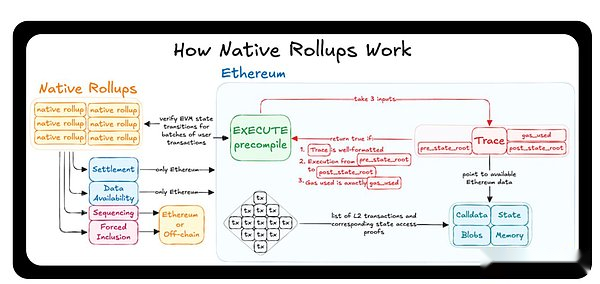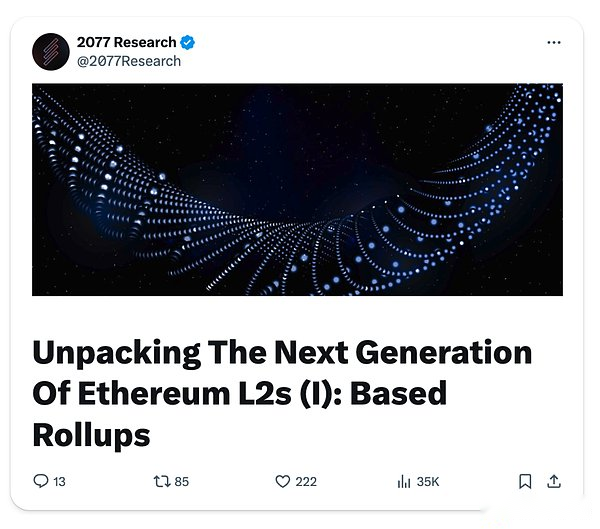
Author: David C Source: bankless Translation: Shan Oppa, Bitchain Vision
Is the end-of-schedule solution for Ethereum expansion finally here?
Despite fierce debates surrounding the expansion roadmap, Ethereum’s expansion still relies on Rollups.Rollups undoubtedly drive the success of Ethereum expansion, but the problem of them being out of sync with the main chain remains.
Rollups need to maintain a dedicated proof mechanism, adding a lot of complexity and operational costs to each Rollup team.Furthermore, they rely heavily on security committees or governance votes to follow up on Ethereum’s upgrades, which leads to lag and disconnect.Different Rollups adopt different security assumptions and degrees of centralization, resulting in ecological fragmentation and reducing interoperability.At the same time, every time Ethereum is hard forked, the Rollup team needs to update manually to maintain compatibility, increasing the governance burden and introducing new risks.
Against the backdrop of the debate over Ethereum expansion route, many people have begun to think about whether there is a simpler solution—This is an L2 solution that does not require heavy maintenance and is always synchronized with Ethereum.
This is the philosophy of Native Rollups – a new Rollup design framework that fundamentally aligns with Ethereum, taking full advantage of the security of the main chain without relying on external supervision or custom logic.Let us gain insight into this concept and its related principles.
Resolve native Rollups
Native RollupsProposed by members of the Ethereum community such as Justin Drake and Dan Robinson, they are directly integrated into Ethereum’s core trading rules, allowing Ethereum itself to verify transactions rather than relying on external proof systems.
Currently, most L2 solutions execute transactions off-chain and use complex proof mechanisms to verify withdrawals and state changes.andNative RollupsTake different approaches and useEXECUTE Precompiled——A built-in function in Ethereum allows Rollups to directly use Ethereum’s verification rules to process transactions without an independent proof system.
Under this architecture, native Rollups directly publishes transaction data to the Ethereum main chain, and Ethereum itself enforces its correctness.This allows them to automatically adapt to Ethereum’s network upgrades without governance votes or security committee intervention, eliminating many of the complexities and interoperability issues that are currently present.
Native Rollups by eliminating the need to repetitively build Ethereum logicReduces maintenance costs, simplifies security mechanisms, and makes L2 easier to adapt to Ethereum’s continuous evolution while maximizing the security of the main chain.

Comparison between native Rollups and other Rollups
To better understandNative RollupsThe importance of , we can compare them with other Rollup schemes currently being explored.
▪️ Based Rollups
BasedRollupsFirst proposed by Vitalik Buterin in 2021 and formally defined by Justin Drake in 2023.This type of RollupsRely on Ethereum L1 validators to sort transactions, thereby improving the decentralization of transaction sorting.
Although there are no fully online Based Rollups yet, teams such as Taiko and Spire Labs are actively advancing their deployment.Although Ethereum’s participation has enhanced decentralization,BasedRollups still need to manage their ownProof System.Because Ethereum L1 has a long block time, the user experience may be affected, butPre-confirmationImprovements in mechanisms are alleviating this problem.
▪️ Booster Rollups
BoosterRollupsBy in Layer 2Copy the execution and stored procedures of Ethereum L1 as much as possible, to enhance the scalability, allowing applications to scale without major refactoring.
This approach, while making existing applications easier to scale, is more complex than traditional Rollups because itMore complex engineering design and unique proof mechanisms are needed.Although Booster Rollups is designed to enable stronger composability and easier application deployment, it still facesEconomic incentivesandUser ExperienceChallenges in the aspects.

▪️ Native Rollups
As mentioned above, unlike the above two solutions,Native Rollups do not require a separate proof framework or external validator, because all verification is done by Ethereum itself.This significantly reduces the complexity of L2 and simplifies its interaction with L1.
Key Benefits of Native Rollups:
Greatly improve safety: Users can hold assets on native Rollup and trust it as much as Ethereum L1.And the risk of multi-signal or security committees that traditional Rollups rely on will be significantly reduced.
Simpler development: No more custom fraud proof or zero-knowledge proof is required, reducing the complexity of deployment and maintenance.
Align more closely with Ethereum:Native RollupsAutomatically inherit the upgrade of Ethereum, ensure consistency and improve interoperability.At the same time, they will also benefit from the future of EthereumQuantum Securitymechanism.
More efficient ZK proof:Native Rollups OKEfficiently bundle multiple zero-knowledge proofs, reduce the verification cost of ZK Rollups.
Suitable for new application chains:For hope to obtainThe highest security levelDecentralized applications, they can choose to become “native” to avoid redeveloping EVMs, but simply add their own special features.
If a RollupIt’s both native and based——That is, Ethereum is managed simultaneouslyTransaction sortingandTransaction Verification, then it becomes an “ultrasound Rollup”This Rollup makes full use of Ethereum’s security and is fully in line with Ethereum’s long-term expansion roadmap. It is the most ideal Rollup form.

Issues that native Rollups cannot solve
althoughNative RollupsGovernance and security challenges are addressed, but they do not completely eliminate Ethereum’s expansion restrictions and even impose additional constraints on ecological diversity in some ways.
L1 Gas restrictions remain: The Gas cap on the Ethereum mainnet is still valid, and if each transaction has to be re-execute on L1, it may result in inefficiency.therefore,Need to combine additional zero-knowledge or Optimistic solutions, to expand more efficiently.
Lack of support for diverse virtual machines: Native Rollups must be strictly followedEVM Model, which means they cannot be supportedSVM or MoveVMand other emerging virtual machine architectures, which are gradually attracting market attention.
Increased cost of data availability: Native Rollups dependenciesEXECUTE PrecompiledmeetingSignificantly increase data availability costs, may lead to an increase in L2 overhead5–10 times, thereby affecting its economic viability.
also,Currently many Rollups are onlyEVM compatible, but not exactly equivalent to EVM.To convert to native Rollup requiresLarge-scale architectural adjustments, it is more difficult.Native Rollups DesignProbably not supportedsomeCustom transaction formatorGas calculation method, such as the model where users’ Gas fees are subsidized by applications or wallets.This brings some trade-offs in user experience (UX).
Take an important step
Although native Rollups is a major advancement on the Ethereum expansion roadmap,Not all Rollups will adopt this model.On the contrary, industry insiders (such as Cyber Fund’s Dogan) believe that the Rollup ecosystem may form three main types in the future:
-
Enterprise-level Rollups:Customized and controlled by the enterprise to meet its specific needs, e.g.Transaction sorting, privacy protectionwait.
-
Performance-optimized Rollups:passAlternative data availability schemes (e.g. EigenDA)Improve transaction speed and reduce costs.
-
Native Rollups:Completely integratedEnter Ethereum, inherit L1 security, andAutomatic upgrade, no external governance or independent proof mechanism is required.
This classification methodEncourages the coexistence of multiple expansion solutions, also allows different Rollups to innovate technologically while retaining Ethereum’s trust and security.Justin Drake expects, the first batch of native RollupsProbably launched next year.However, to achieve complete technological maturity (e.g.Native support for ZK proof, enhance L1 Gas restrictions), still needWidesome community coordination and verification, complete implementation may be further delayed to the further future.
althoughNative Rollups may not be the only solution for Ethereum extensions, but theyProvides a simpler, safer, and deeper integration with Ethereum.final,Native Rollups provide a clear direction for L2s to keep them in sync with the Ethereum main chain at all times, thus bringing a smoother and safer experience to users, developers and the entire ecosystem.







